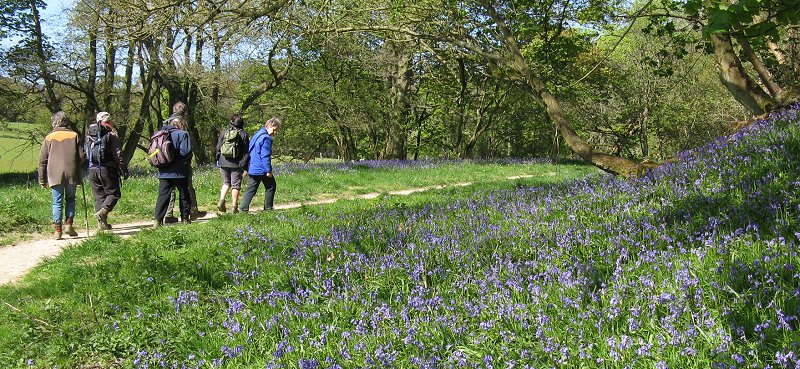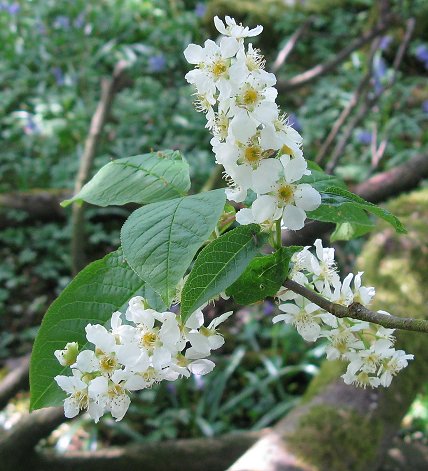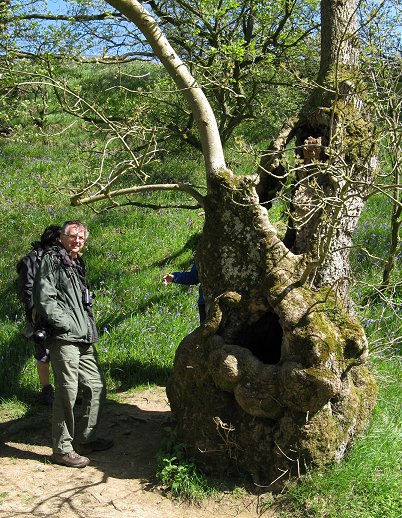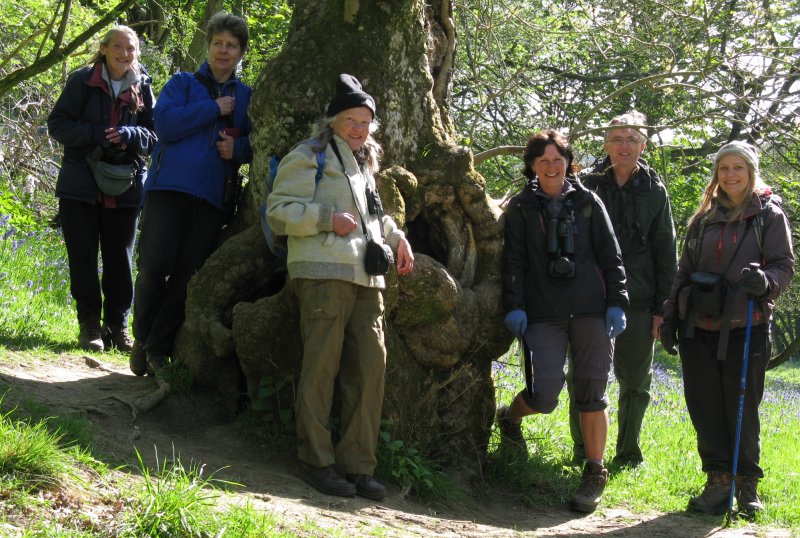
Back to the Home page
Species lists below

The Farndale daffodil walk, which takes us north along the River Dove from Low Mill to Church Houses, is the first of two outings forming this year’s study. Included in the walk was the return to Low Mill via the road on the east side. Whilst the daffodil walk is famous far and wide for its wild daffodils it is also important to record other flora and fauna along its route. It is worthy of note how clean the area was, the river devoid of any debris and the walkway free of litter. Very welcome on a well trodden path at this time of year.
Eight members turned out on a fine and sunny afternoon but were dogged by a cold north wind which must have kept some wildlife at bay. For example, we only had one small white butterfly and two bumblebee species. However, we had a good list of birds (40) and flora (107) which will most certainly be added to on our July visit. The River Dove meanders along its route and sunny sheltered spots were numerous. Of particular note were seven male and two female redstarts and a spotted flycatcher along the Dove. A further male redstart and another spotted flycatcher were noted along the roadside. A flock of up to 20 golden plovers were feeding in the pastures below the moor. We were also blessed with the sound of the cuckoo. What was of note was the lack of birds of prey with no single sighting.

The course of the River Dove is lined with the usual trees - alder, ash, elder, hazel, holly, oak and sycamore. The hedgerows are full of hawthorn and blackthorn, the latter having flowered and the former about to burst in to bloom. All trees were interspersed with flowering bird cherry. This visit was perfect for spring flora, the river banks being particularly lush. The wild daffodil, although at the end of their flowering season, dominate the edges of the River Dove but other flora soon takes over and catches the eye. Extensive swathes of marsh marigold Caltha palustris were impressive and there was one big patch of large bittercress Cardamine amara, its violet anthers showing well against the white petals. Bluebells also cover small areas along the route.

|
 |

Two pieces of the slime mould False puffball Reticularia lycoperdon previously classified as Enteridium lycoperdon were found on a dead tree, probably alder. It is of particular note due to its curious appearance and behaviour. Slime moulds are no longer classed as fungi but are now known to be Myxomycota, which are a class of amoeboid protozoa, organisms which prey on microbial food webs. These specimens started as fruiting bodies known as a sporangium which swell and harden. They form a silvery-grey papery skin which is depicted here. They eventually split to release a mass of dark brown spores. After the spores have dispersed a faint brown spore print is left on the bark. One of the specimens is just starting to split. A fascinating process.

|
 |
All in all an enjoyable trip and a worthwhile area to form this year’s study.


Stone water troughs at Low Mill
| Latin name | Common name |
|---|---|
| Acer pseudoplatanus | Sycamore |
| Achillea millefolium | Yarrow |
| Ajuga reptans | Bugle |
| Alliaria petiolata | Hedge Garlic or Jack by the Hedge |
| Allium ursinum | Ramsons |
| Alnus glutinosa | Alder |
| Alopecurus pratensis | Foxtail, Meadow |
| Anemone nemorosa | Wood anemone |
| Angelica sylvestris | Angelica |
| Anthoxanthum odoratum | Sweet Vernal Grass |
| Anthriscus sylvestris | Cow parsley |
| Arctium minus | Burdock |
| Bellis perennis | Daisy |
| Brachypodium sylvaticum | Slender False Brome |
| Caltha palustris | Marsh marigold |
| Cardamine amara | Bittercress, large |
| Cardamine flexuosa | Bittercress, wavy |
| Cardamine hirsuta | Bittercress, hairy |
| Cardamine pratensis | Cuckoo flower or Milkmaid |
| Centaurea nigra | Knapweed, common |
| Chrysosplenium oppositifolium | Golden saxifrage, opposite leaved |
| Cirsium arvense | Thistle, creeping |
| Cirsium palustre | Thistle, marsh |
| Claytonia sibirica | Pink purslane |
| Conium maculatum | Hemlock |
| Conopodium majus | Pignut |
| Corylus avellana | Hazel |
| Crataegus monogyna | Hawthorn |
| Digitalis purpurea | Foxglove |
| Dryopteris dilatata | Common Buckler Fern |
| Epilobium hirsutum | Willowherb, great |
| Equisetum sylvaticum | Wood Horsetail |
| Filipendula ulmaria | Meadowsweet |
| Fragaria vesca | Strawberry, wild |
| Fraxinus excelsior | Ash |
| Galium aparine | Cleavers |
| Geranium robertianum | Herb robert |
| Geum urbanum | Avens, wood |
| Glechoma hederacea | Ground ivy |
| Hedera helix | Ivy |
| Heracleum sphondylium | Hogweed |
| Hyacinthoides non-scripta | Bluebell |
| Hypericum pulchrum | St Johnswort, beautiful |
| Ilex aquifolium | Holly |
| Iris pseudacorus | Yellow iris or Flag |
| Juncus effusus | Soft Rush |
| Lamium album | Deadnettle, white |
| Lamium purpureum | Deadnettle, red |
| Larix sp. (L. decidua) | Larch |
| Lathyrus linifolius | Vetch, bitter |
| Lathyrus pratensis | Meadow vetchling |
| Lonicera periclymenum | Honeysuckle |
| Lotus corniculatus | Birdsfoot trefoil, common |
| Luzula campestris | Woodrush, field |
| Luzula sylvatica | Woodrush, great |
| Lychnis flos-cuculi | Ragged robin |
| Lysimachia nemorum | Yellow pimpernel |
| Malus sylvestris | Crab apple |
| Matricaria discoidea | Pineapple weed |
| Meconopsis cambrica | Poppy, Welsh |
| Mercurialis perennis | Dogs mercury |
| Mycelis muralis | Wall lettuce |
| Myosotis sylvatica | Forgetmenot, wood |
| Myrrhis odorata | Sweet cicely |
| Narcissus pseudonarcissus | Wild daffodil |
| Oxalis acetosella | Wood sorrel |
| Phyllitis scolopendrium | Hartstongue |
| Plantago lanceolata | Plantain, ribwort |
| Plantago major | Plantain, greater |
| Polypodium vulgare | Common Polypody |
| Potentilla anserina | Silverweed |
| Potentilla sterilis | Strawberry, barren |
| Primula vulgaris | Primrose, common |
| Prunus padus | Bird cherry |
| Prunus spinosa | Blackthorn |
| Pteridium aquilinum | Bracken |
| Quercus sp. | Oak |
| Ranunculus acris | Buttercup, meadow |
| Ranunculus ficaria | Celandine, lesser |
| Ranunculus repens | Buttercup, creeping |
| Ribes rubrum | Currant, red |
| Ribes uva-crispa | Gooseberry |
| Rubus fruticosus | Bramble |
| Rubus idaeus | Raspberry |
| Rumex acetosa | Sorrel, common |
| Rumex crispus | Dock, curled |
| Rumex obtusifolius | Dock, broad leaved |
| Rumex sanguineus | Dock, wood |
| Sambucus nigra | Elder |
| Senecio jacobea | Ragwort, common |
| Silene dioica | Campion, red |
| Sorbus aucuparia | Rowan |
| Stachys sylvatica | Woundwort, hedge |
| Stellaria holostea | Stitchwort, greater |
| Symphoricarpos albus | Snowberry |
| Taraxacum sp. | Dandelion |
| Teucrium scorodonia | Wood sage |
| Trifolium repens | Clover, white |
| Urtica dioica | Nettle, common |
| Vaccinium myrtillus | Bilberry |
| Veronica beccabunga | Speedwell, brooklime |
| Veronica chamaedrys | Speedwell, germander |
| Veronica montana | Speedwell, wood |
| Veronica serpyllifolia | Speedwell, thyme leaved |
| Vicia sepium | Vetch, bush |
| Viola riviniana | Violet, common dog |
| ? Athyrium filix-femina | Lady Fern |
| ? Epilobium tetragonum | Willowherb, square stalked |
| ? Rosa canina | Rose, dog |
Mammals: hare, rabbit, stoat
Butterflies: small white
Bumblebees: white-tailed Bombus lucorum queen, buff-tailed Bombus terrestris queen
Birds: blackbird, blackcap, black headed gull, blue tit, chaffinch, chiffchaff, coal tit, collared dove, cuckoo, curlew, dipper, dunnock, golden plover, goldfinch, greater spotted woodpecker, great tit, grey wagtail, house martin, house sparrow, jackdaw, lapwing, linnet, long tailed tit, mallard duck, marsh tit, meadow pipit, mistle thrush, pied wagtail, redstart, robin, song thrush, spotted flycatcher, starling, swallow, swift, treecreeper, tree sparrow, willow warbler, wood pigeon, wren
Fungi: Daedalopsis confragosa (blushing bracket) on willow, Stereum sp on willow, Uromyces muscari (rust) on bluebell
Myxomycete: Enteridium lycoperdon
| © Ryedale Natural History Society 2016, Photos © Gill Smith, Jayne Smith 2016 |